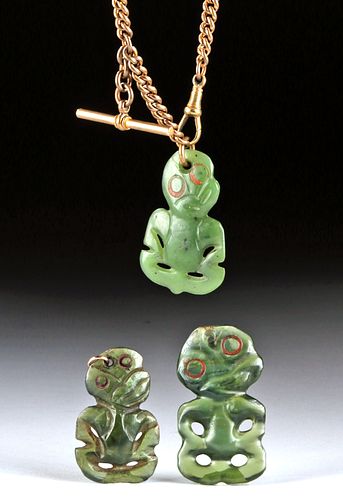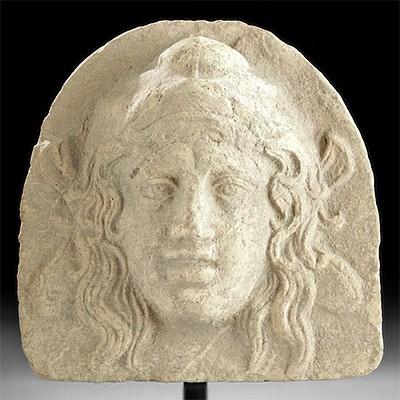Early 20th C. Maori Jade / Stone Hei Tikis (3)
Lot 166a
About Seller
Artemis Fine Arts
686 S Taylor Ave, Ste 106
Louisville, CO 80027
United States
Selling antiquities, ancient and ethnographic art online since 1993, Artemis Gallery specializes in Classical Antiquities (Egyptian, Greek, Roman, Near Eastern), Asian, Pre-Columbian, African / Tribal / Oceanographic art. Our extensive inventory includes pottery, stone, metal, wood, glass and textil...Read more
Categories
Estimate:
$4,000 - $6,000
Absentee vs Live bid
Two ways to bid:
- Leave a max absentee bid and the platform will bid on your behalf up to your maximum bid during the live auction.
- Bid live during the auction and your bids will be submitted real-time to the auctioneer.
Bid Increments
| Price | Bid Increment |
|---|---|
| $0 | $25 |
| $300 | $50 |
| $1,000 | $100 |
| $2,000 | $250 |
| $5,000 | $500 |
| $10,000 | $1,000 |
| $20,000 | $2,500 |
| $50,000 | $5,000 |
| $100,000 | $10,000 |
| $200,000 | $20,000 |
About Auction
By Artemis Fine Arts
Feb 27, 2020
Set Reminder
2020-02-27 10:00:00
2020-02-27 10:00:00
America/New_York
Bidsquare
Bidsquare : VARIETY SALE | Antiquities & Ethnographic Art
https://www.bidsquare.com/auctions/artemis-gallery/variety-sale-antiquities-ethnographic-art-4920
Around the world & back in time - be amazed at the treasures you will find. Antiquities from Egypt, Greece, Italy and the Near East, Asian, Pre-Columbian, African / Tribal / Oceanic, Native American, Spanish Colonial, Russian Icons, Fine Art, much more! Artemis Fine Arts info@artemisfinearts.com
Around the world & back in time - be amazed at the treasures you will find. Antiquities from Egypt, Greece, Italy and the Near East, Asian, Pre-Columbian, African / Tribal / Oceanic, Native American, Spanish Colonial, Russian Icons, Fine Art, much more! Artemis Fine Arts info@artemisfinearts.com
- Lot Description
Oceania, New Zealand, Maori, ca. 1900 CE. A trio of well-carved hei tiki Maori pendants, with one made from a milky green nephrite jade, the other two from green stones, probably green obsidian. Each depicts a stylized human figure. All three of these are genderless; hei tiki are either female or without visible signs of gender. Each has its hands that rest atop its knees, with its lower legs and feet joined together as if crossed; the head is tilted to the right. All three have incised faces with reddish pigment in the deep grooves that outline the large, perfectly round eyes. Their mouths are large, with the lips set, and twin lines serving as the nose. Originally, each was made to be a pendant worn on a necklace. One comes with a mid-20th century brass chain for suspension. Size of largest: 1.15" W x 2.1" H (2.9 cm x 5.3 cm)
In Polynesian culture including the Maori, the word "tiki" means carved human figure, possibly originating from the myth of Tiki, the first man. Tiki are common through Polynesia, but the hei tiki, the pendant form seen here, is uniquely Maori. The flattened shape, replicated for nearly all hei tiki, is probably because these are made from adze blades. Examples of half-carved hei tiki/adzes have been found, and sometimes on completed tiki a portion of the original cutting surface remains. The nephrite stone was carved into prestigious goods in pre-European New Zealand and the Maori name for the South Island, Ti Wai Pounamu, refers to the stone because it is sourced from there. Since contact with Europeans, the hei tiki have become symbols of the Maori people and by extension of New Zealand - Air New Zealand passengers in the 1960s and 1970s received small green plastic replicas, and photos from the Beatles 1964 tour of the country show them wearing them around their necks.
Provenance: ex-San Francisco, California, USA collection
All items legal to buy/sell under U.S. Statute covering cultural patrimony Code 2600, CHAPTER 14, and are guaranteed to be as described or your money back.
A Certificate of Authenticity will accompany all winning bids.
We ship worldwide and handle all shipping in-house for your convenience.
#148849All three are intact, with light signs of wear commensurate with age. The brass chain on one is mid-20th century CE; however, the hei tiki it is holding as well as the other hei tikis are antique - ca. 1900 CE.Condition
- Shipping Info
-
All shipping is handled in-house for your convenience. Your invoice from Artemis Gallery will include shipping calculation instructions. If in doubt, please inquire BEFORE bidding for estimated shipping costs for individual items.
-
- Buyer's Premium



 EUR
EUR CAD
CAD AUD
AUD GBP
GBP MXN
MXN HKD
HKD CNY
CNY MYR
MYR SEK
SEK SGD
SGD CHF
CHF THB
THB














